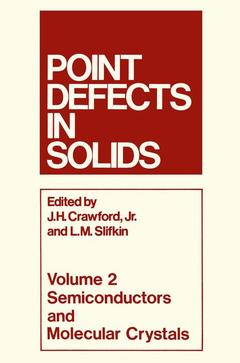Point Defects in Solids, Softcover reprint of the original 1st ed. 1975 Volume 2 Semiconductors and Molecular Crystals
Langue : Anglais
Auteurs : Crawford James H., Slifkin Lawrence M.

Volume 1 of Point Defects in Solids has as its major emphasis defects in ionic solids. Volume 2 now extends this emphasis to semiconductors. The first four chapters treat in some detail the creation, kinetic behavior, inter actions, and physical properties of both simple and composite defects in a variety of semiconducting systems. Also included, as in Vol. 1, are chapters on special topics, namely phonon-defect interactions and defects in organic crystals. Defect behavior in semiconductors has been a subject of considerable interest since the discovery some twenty-five years ago that fast neutron irradiation profoundly affected the electrical characteristics of germanium and silicon. Present-day interest has been stimulated by such semiconductor applications as solar cell power plants for space stations and satellites and semiconductor particle and y-ray detectors, since in both radiation damage can cause serious deterioration. Of even greater practical concern is the need to understand particle damage in order to capitalize upon the develop ing technique of ion implantation as a means of device fabrication. Although the periodic international conferences on radiation effects in semiconductors have served the valuable function of summarizing the extensive work being done in this field, these proceedings are much too detailed and lack the background discussion needed to make them useful to the novice.
1. Defect Creation in Semiconductors.- 1. Introduction.- 2. Defect Properties.- 3. Damage Phenomenology.- 4. Interactions of Particles with Semiconductors.- 5. Survey of Displacement Damage Results.- 6. Subthreshold and Ionization Damage.- 7. Theories of Displacement Damage Production.- 8. Summary.- References.- 2. Diffusion in Semiconductors.- 1. Introduction.- 2. Atomic Theory of Diffusion.- 3. Continuum Theory of Diffusion.- 4. Diffusion in Ge and Si.- 5. Diffusion in the III–V Compounds.- 6. Diffusion in the II–VI Compounds.- 7. Summary and Conclusions.- References.- 3. Effects of Point Defects on Electrical and Optical Properties of Semiconductors.- 1. Introduction.- 2. Carrier Concentration.- 3. Carrier Mobility.- 4. Minority Carrier Lifetime.- 5. Optical Absorption.- 6. Photoconductivity.- 7. Luminescence.- 8. Conclusion.- References.- 4. Electron Paramagnetic Resonance of Point Defects in Solids, with Emphasis on Semiconductors.- 1. Introduction.- 2. Basic Concepts.- 3. Theory of EPR for Defects in Solids.- 4. Additional Examples.- 5. Auxiliary Techniques.- References.- 5. Phonon-Defect Interaction.- 1. Introduction.- 2. Theoretical Background.- 3. External Interactions.- 4. Internal Interactions.- 5. Summary and Conclusion.- References.- 6. Point Defects in Molecular Solids.- 1. Introduction.- 2. Self-Diffusion.- 3. Experimental Determination of the Formation and Migration Parameters for Point Defects.
Date de parution : 12-2012
Ouvrage de 480 p.
15.2x22.9 cm
Mots-clés :
Plantation; behavior; cell; crystal; diffusion; dispersion; electron; magnetism; molecular solid; neutron; plants; radiation; scattering; semiconductor; solar
© 2024 LAVOISIER S.A.S.



